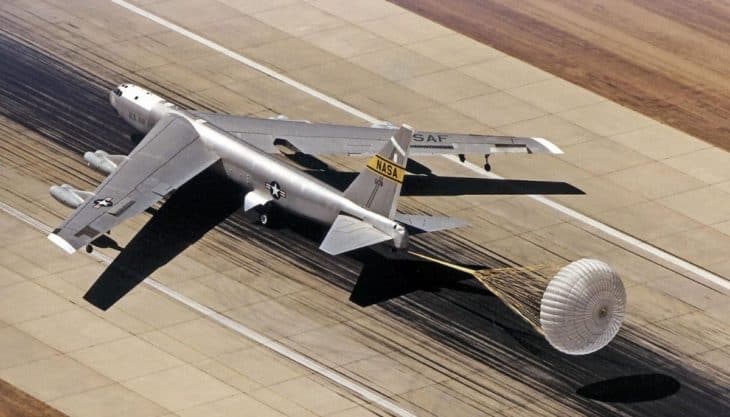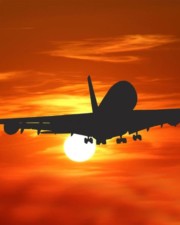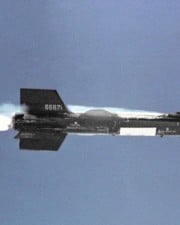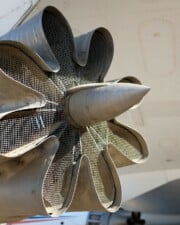Large commercial airliners can have baffling weights. In the case of the A380-800 for instance, the max landing weight is 386 metric tons. How do these huge airplanes brake when landing and what kind of brakes do airplanes have?
Do Airplanes Have Brakes?
In short: Yes, airplanes do have brakes. Airplanes have disc brakes similar to the ones on your car, albeit in a more heavy duty form. These disc brakes alone are not enough to bring the airplane to a safely controlled standstill though. To slow down as quickly as possible and to maximize the function of the wheel brakes, jet airplanes also commonly use thrust reversers and flaps. These systems are engaged after the wheels of the airplane touch the runway during landing.

Airplanes are fascinating machines. Apart from the fact that they can take you from one place to another in mere hours, there are also some interesting facts about them, which can be difficult for a human mind to comprehend.
For instance, not a lot of people know this, but according to flight-tracking service FlightAware, at any given time, there are 9,700 planes in the sky. That means that there are almost 1.2 million people in the sky. Another thing that often baffles people are the brakes in an airplane. Often people ask about how an airplane applies brakes.
There are two kinds of brakes in an airplane: air brakes and landing brakes. Just like the brakes on a vehicle, the wheels of most of the airplanes also have brakes. But those can only be used when the plane touches the ground.

History of Airplane Brakes
Back when the airplane industry was just starting, there were no brakes on an airplane. Instead of the brakes, the pilots relied on slow speed, soft airfield surfaces, and the friction caused by the skidding of the tail to reduce the speed of the airplane once it hit the ground.
But after World War I, brake systems were designed for aircraft. As technology started progressing, aircraft grew larger, and people started using smooth and paved runways.
How Do Airplanes Brake When Landing?
Even though airplanes have become one of the most convenient ways of traveling in the modern world, there are very few people who are aware of how it operates. As we all know, when a plane is about to land, it is at high speed, typically 165 mph. The question here is that how can a plane de-accelerate safely, even though it is coming at such a high speed?

To understand the answer to this question, we have to understand how braking works, not just in an airplane, but in any vehicle which has wheels. As we have already mentioned above how the braking process exerts a torque on the wheels due to which friction is produced. As a result, friction is produced with the ground, and it loses kinetic energy, and hence, the vehicle stops.
But the thing about friction is that it depends entirely on the weight of the vehicle. In the case of the airplane, when it is landing, the aerodynamic lift renders the weight of the plane zero, and hence, the brakes on the wheels are pretty much inefficient to stop the plane. That is why the plane needs to find other ways to stop until both the aerodynamic lift and the speed has reached a sufficient stage.

Modern aircraft use two different braking systems to do this: the spoilers and the thrust reversers. The interesting thing here is that both of these systems are controlled by a computer. As soon as the wheels are put on the ground, the spoilers fully activate themselves. These spoilers are actually flaps which are located on the end of the wings. They function to reduce the aerodynamic lift and increase the drag.
These flaps are an important factor in the braking system because, without them, the friction of the wheels will not be enough for efficient braking. The second system, the reversers, are located in the engines and can be activated, so the exhaust of the engine is redirected forward, as opposed to backward. These reversers also help in reducing the amount of stress the wheels have to tolerate. And although they are controlled by the computers, in the case of an emergency, the pilots are prepared to take over manually.
How Do Pilots Control The Brakes?
Today, all modern airplanes are equipped with brakes. For an airplane to land successfully on the ground, it is imperative that those brakes function properly. The brakes are responsible for reducing the speed of the airplane.
In doing so, the airplanes take a significant amount so they can stop at the right time. They are also responsible for holding the airplane stationary during the engine run-up process and are responsible for steering it during the taxi.
Most of the wheels of an airplane are equipped with a brake unit. The nose and the tail wheel however, do not have brakes. In any typical airplane, pilots can control the brakes by the mechanical/hydraulic linkages to the rudder pedal.
When a pilot pushes the top of the right pedal, it activates the brakes on the right main wheel/wheels, and when the pilot pushes the top of the left rudder pedal, it activates the brake on the left main wheel/wheels.
The brakes work in a rather simple way: they convert the kinetic energy of motion into heat energy. This is done with the help of friction. Due to friction, a lot of heat is generated. For brakes to function effectively, it is important that they are properly maintained, inspected, and adjusted.
Types and Construction of Airplane Brakes
Modern airplanes use disc brakes. The disc rotates as the turning wheel assembly rotates, but when brakes are applied, a stationary caliper resists the rotation by causing friction against the disc. The design of the disc brake system and how complex it is varies from one airplane to another.
It all depends on the size, weight, and the landing speed of the aircraft. Although there are a lot of types of brakes, we will study the most common ones: single brakes, dual brakes, and multiple brakes.
The large aircraft use segmented rotor brakes while older, larger aircrafts used expander tuber brakes. So let’s delve into the types of brakes:
Single disc brakes
Single disc brakes are commonly used by small and light aircrafts. In this type of brake, a single disc is keyed or bolted to each wheel. When the wheel turns, the disc turns as well. A non-rotating caliper is bolted to the landing gear axle flange. This helps in applying the brakes when friction is applied on both sides of the disc.

Dual disc brakes
When a single disc on every wheel is not sufficient to apply brakes, dual disc brakes are used. While a single disc is keyed to the wheel in single disc brakes, here, two discs are keyed to the wheel. There is a center carrier which is located between the two discs. It has linings on both its sides which contacts all the discs when the brakes are applied. These dual disc brakes are mostly used in large and heavy aircraft.
Multiple disc brakes
The third type of brakes which is most commonly used is the multiple disc brakes. Such type of brakes is considered to be heavy-duty brakes. The brake assembly system includes an extended bearing carrier. This extended bearing carrier is similar to a torque tube unit which is bolted to the axle flange. Its function is to support the various parts of a brake including an annular cylinder, a piston, a backplate and a backplate retainer.
References:
http://junq.info/?p=2994
https://www.aircraftsystemstech.com/p/aircraft-brakes_9081.html
Related Posts














